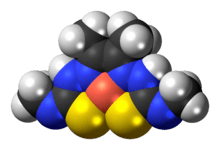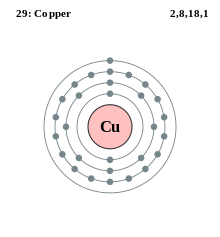Copper-64

Properties
64Cu has a half-life of 12.701 ± 0.002 hours and decays by 17.86 (± 0.14)% by positron emission to 64Ni, 39.0 (± 0.3)% by beta decay to 64Zn, 43.075 (± 0.500)% by electron capture to 64Ni, and 0.475 (± 0.010)% gamma radiation/internal conversion. These emissions are 0.5787 (± 0.0009) and 0.6531 (± 0.0002) MeV for beta minus and positron respectively and 1.35477 (± 0.00016) MeV for gamma.[1]
The main oxidation states of copper are I and II since Cu3+ is too powerful to exist in biochemical systems. Furthermore, copper(I) exists as a strong complex in aqueous solution and is not often seen. Copper(II) forms mononuclear complexes that are paramagnetic and prefers ligands of sulfur and nitrogen.[2]
Copper is essential in the human body as both a catalyst and as part of enzymes. Copper is mainly involved in redox reactions throughout the body, but also plays a role in iron transportation in blood plasma.
Production
Copper-64 can be technically reproduced by several different reactions with the most common methods using either a reactor or an accelerator. Thermal neutrons can produce 64Cu in low specific activity (the number of decays per second per amount of substance) and low yield through the 63Cu(n,γ)64Cu reaction. At the University of Missouri Research Reactor Center (MURR) 64Cu was produced using high-energy neutrons via the 64Zn(n,p)64Cu reaction in high specific activity but low yield. Using a biomedical cyclotron the 64Ni(p,n)64Cu nuclear reaction can produce large quantities of the nuclide with high specific activity.[2]
Applications
Wilson’s disease
Wilson’s disease is a rare condition in which copper is retained excessively in the body. Toxic levels of copper can lead to organ failure and premature death. 64Cu is used to study whole body retention of copper in subjects with this disease. The technique can also separate heterozygous carriers and homozygous normals.
Assessment of renal perfusion with Cu-ETS2
Ethylglyoxal bis(thiosemicarbazone) has potential utility as a PET radiopharmaceutical with the various isotopes of copper. 62Cu can be produced by a generator from the decay of 62Zn and has a half-life of under 10 minutes. It has also been used for myocardial, cerebral and tumor profusion evaluations. 64Cu has a much longer half-life and can be used with Cu-ETS as well since there is a linear relationship between the renal uptake and blood flow. Renal perfusion can also be evaluated with CT or MRI instead of PET, but with drawbacks: CT requires administration of potentially toxic contrast agents, and if repeated scans are required, CT will expose the patient to even more ionizing radiation. MRI avoids this radiation but is difficult to implement, and often suffers from motion artifacts. Thus, PET scans utilizing copper isotopes offer quantitative measurements and are suitable for use in regional renal perfusion assessments.[3]
Bifunctional chelates as copper carriers
Dissociation of copper from bifunctional chelates
The in vivo metabolism of bifunctional chelates is important for optimal targeting of specific organs or tumors. 64Cu TETA-Octreotide is a chelate that has been shown to bind to the somatostatin receptor. This in turn inhibited the growth of somatostatin-receptor positive tumors in rats. This compound however showed activity in blood, liver and bone marrow. Whether the chelate dissociated and resulted in 64Cu binding to the protein superoxide dismutase (SOD) in rat liver was investigated by utilizing a gel electrophoresis assay for the detection of SOD. It was shown that 64Cu did in fact dissociate from the TETA chelator and bound to SOD, and to a lesser extent, other proteins. This is caused either because chelate-biomolecules are not thermodynamically stable or are not kinetically stable. Kinetic stability is more central in the determination of in vivo stability than thermodynamic stability however. To prevent this unwanted dissociation, molecules of higher stability are needed.[4]
Investigating methanephosphonate tetraaza macrocyclic ligands
Three different compounds of tetraazacyclododecane ligands with methanephosphonate functional groups were synthesized and tested for their in vivo stability. These were all labeled with 64Cu and then studied for their biodistribution in rat organs (liver, kidney, blood and bone). 64Cu-DO2P demonstrated the most efficient clearance through the blood, liver and kidney of all the ligands tested and had similar uptake and clearance in those organs as did Cu-TETA. The 64Cu-DO2P ligand had the highest in vivo stability and thus makes it a strong candidate for copper radiopharmaceuticals.[5]
Investigating cross-bridged tetraaza ligands
To better understand the in vivo stability of peptide conjugated CB-TE2A and Cu-TETA, cross-bridged monoamides were synthesized and tested for their biodistribution. CB-TEAMA, CB-MeTEAMA and CB-PhTEAMA were all produced. Retention in nontarget tissues such as the liver make full characterization of the peptide difficult, so molecules which clear those organs are necessary. The results showed that CB-TE2A did in fact have good biodistribution and in vivo stability as well as all cross-bridged complexes. Thus, this is evidence in favor of CB-TE2A as a bifunctional chelator without additional modification.[6]
Cancer detection with bombesin analogs
The Bombesin peptide has been shown to be overexpressed in BB2 receptors in prostate cancer. CB-TE2A a stable chelation system for 64Cu was incorporated with Bombesin analogs for in vitro and in vivo studies of prostate cancer. PET/CT imagining studies showed that it underwent uptake into prostate tumor xenografts selectively with decreased uptake into non target tissues. Other studies have shown that by targeting the gastrin-releasing peptide receptor pancreatic and breast cancer can be detected with PET imagining.[7]
Cancer therapy
64Cu-ATSM (diacetyl-bis(N4-methylthiosemicarbazone)) has been shown to increase the survival time of tumor-bearing animals with no acute toxicity. Areas of low oxygen retention have been shown to be resistant to radiotherapy because hypoxia reduces the lethal effects of ionizing radiation. 64Cu was believed to kill these cells because of its unique decay properties. In this experiment, animal models having colorectal tumors with and without induced hypoxia were administered Cu-ATSM. Cu-ATSM is preferentially taken up by hypoxic cells over normoxic cells. The results demonstrated that this compound increased survival of the tumor bearing hamsters compared with controls. In the control groups, death due to tumor burden occurred within 20 days weeks while animals with a dose greater than 6 mCi of the radioisotope tumor growth was inhibited and survival increased to 135 days in 50% of animals. The results also suggested that multiple doses and a single dose of 10 mCi were equally effective while the multiple dose regimen is safer for non-target tissue.[8]
Radiotherapy of cancer cells using 64Cu can be applied in medical research and clinical practice. The advantages of radiotherapy with beta emitters of this energy are that there is enough to do substantial damage to the target cells but the mean range in tissue is less than a millimeter so non target tissues are unlikely to be harmed.[8] In addition, 64Cu is a positron emitter making it a viable PET imaging radionuclide which can give real time images of the physiological processes in the system. These abilities in conjunction enable accurate monitoring of drug distribution and biokinetics simultaneously. Radiotherapeutic efficacy of copper-64 depends highly upon the radioligand delivery to the target cells, so the development of bifunctional chelates is central to development of 64Cu’s potential as a radiopharmaceutical.
Notes
- ↑ Monographie BIPM-5, Table of radionuclides, published in three volumes with accompanying comments: Table of contents Bé M.-M., Chisté V., Dulieu C., Browne E., Chechev V., Kuzmenko N., Helmer R., Nichols A., Schönfeld E., Dersch R., Vol. 1 (2004, 285 pp), Vol. 2 (2004, 282 pp) and Comments on the 2004 evaluation (Vols. 1-2) (2004, 474 pp); Bé M.-M., Chisté V., Dulieu C., Browne E., Baglin C., Chechev V., Kuzmenko N., Helmer R., Kondev F., MacMahon D., Lee K.B., Vol. 3 (2006, 210 pp) and Comments on the 2006 evaluation (Vol. 3) (2006, 186 pp).
- 1 2 Welch, Michael J. and Carol S. Redvanly. Handbook of Radiopharmaceuticals. England: John Wiley and Sons, 2003.
- ↑ Green, Mark A. “Assessment of Cu-ETS as a PET radiopharmaceutical for evaluation of regional renal perfusion.” Nuclear Medicine and Biology 34.3 (2007):247-255.
- ↑ Bass, Laura A. “In Vivo Transchelation of Copper-64 from TETA-Octreotide to Superoxide Dismutase in Rat Liver.” Bioconjugate Chemistry 11 (2000): 527-532.
- ↑ Sun, Xiankai. “In vivo behavior of copper-64-labeled methanephosphonate tetraaza macrocyclic ligands.” Journal of Biological Inorganic Chemistry 8 (2003): 217-225.
- ↑ Sprague, Jennifer E. “Synthesis, Characterization and In Vivo Studies of Cu(II)-64-Labeled Cross-Bridged Tetraazamacrocycle-amide Complexes as Models of Peptide Conjugate Imaging Agents.” Journal of Medicinal Chemistry 50.10 (2007): 2527-2535.
- ↑ Parry, Jesse J. “MicroPET imaging of breast cancer using radiolabeled bombesin analogs targeting the gastrin-releasing peptide receptor.” Springer 101 (2007): 175-183.
- 1 2 Lewis, Jason S. “Copper-64-diacetyl-bis(N4-methylthiosemicarbazone): An agent for radiotherapy.” Proceedings of the National Academy of Sciencies 98.3 (2001): 1206-1211.
References
- Bass, Laura A. “In Vivo Transchelation of Copper-64 from TETA-Octreotide to Superoxide Dismutase in Rat Liver.” Bioconjugate Chemistry 11 (2000): 527-532.
- Green, Mark A. “Assessment of Cu-ETS as a PET radiopharmaceutical for evaluation of regional renal perfusion.” Nuclear Medicine and Biology 34.3 (2007):247-255.
- Lewis, Jason S. “Copper-64-diacetyl-bis(N4-methylthiosemicarbazone): An agent for radiotherapy.” Proceedings of the National Academy of Sciencies 98.3 (2000): 1206-1211.
- Loveland, Walter, David J. Morrisey and Glenn T. Seaborg. Modern Nuclear Chemistry. New Jersey: John Wiley and Sons, 2006.
- Parry, Jesse J. “MicroPET imaging of breast cancer using radiolabeled bombesin analogs targeting the gastrin-releasing peptide receptor.” Springer 101 (2007): 175-183.
- Sprague, Jennifer E. “Synthesis, Characterization and In Vivo Studies of Cu(II)-64-Labeled Cross-Bridged Tetraazamacrocycle-amide Complexes as Models of Peptide Conjugate Imaging Agents.” Journal of Medicinal Chemistry 50.10 (2007): 2527-2535.
- Sun, Xiankai. “In vivo behavior of copper-64-labeled methanephosphonate tetraaza macrocyclic ligands.” Journal of Biological Inorganic Chemistry 8 (2003): 217-225.
- Tubis, Manuel and Walter Wolf. Radiopharmacy. New York: John Wiley and Sons, 1976.
- Monographie BIPM-5, Table of radionuclides, published in three volumes with accompanying comments:
Table of contents Bé M.-M., Chisté V., Dulieu C., Browne E., Chechev V., Kuzmenko N., Helmer R., Nichols A., Schönfeld E., Dersch R., Vol. 1 (2004, 285 pp), Vol. 2 (2004, 282 pp) and Comments on the 2004 evaluation (Vols. 1-2) (2004, 474 pp); Bé M.-M., Chisté V., Dulieu C., Browne E., Baglin C., Chechev V., Kuzmenko N., Helmer R., Kondev F., MacMahon D., Lee K.B., Vol. 3 (2006, 210 pp) and Comments on the 2006 evaluation (Vol. 3) (2006, 186 pp).
